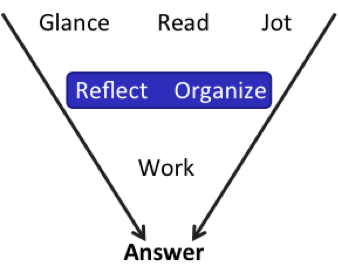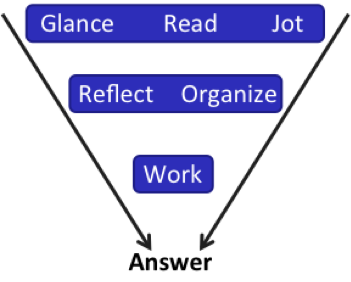Decoding Divisibility and Primes on the GMAT – Part 3
 Did you know that you can attend the first session of any of our online or in-person GMAT courses absolutely free? We’re not kidding! Check out our upcoming courses here.
Did you know that you can attend the first session of any of our online or in-person GMAT courses absolutely free? We’re not kidding! Check out our upcoming courses here.
Welcome to the 3rd and final installment of our mini-series on GMAT Number Properties. We’ve been doing a deep dive into Divisibility and Prime issues (see Part 1 and Part 2), exploring how the GMAT can disguise these topics and get us to fall into traps.
Here’s your third GMATPrep® problem from the free exams—and our hardest one yet. Good luck!
“*For every positive even integer n, the function h(n) is defined to be the product of all the even integers from 2 to n, inclusive. If p is the smallest prime factor of h(100) + 1, then p is
“(A) between 2 and 10
“(B) between 10 and 20
“(C) between 20 and 30
“(D) between 30 and 40
“(E) greater than 40”
Yikes. Where to start?
Glance: PS. A lot of words. The answers are in a weird form. But maybe that means I can estimate?
Read: Ugh: functions. I need to jot this down while I’m reading in order to figure out what it means.
Jot:

Okay. So the function equals the evens multiplied together…
h(100) = (2)(4)(6)(…)(100)… And then I have to add 1.
What does that mean? I’m not really sure. I have to think about this using a real number. 2 is the smallest prime number period; could it be a prime factor of that h(100) + 1 thing?
Let’s see. 2 is a factor of h(100), because h(100) = (2)(4)(6)(…)(100).
And then if I add 1…oh, 2 can’t be a factor if I add 1! That would make h(100) odd, and anything odd doesn’t have 2 as a factor! Okay.
I can’t keep testing every prime, of course, but I haven’t found a pattern yet. There must be a pattern, since nobody could really calculate this number without a computer. So I think I’ve found my path; I’m going to try 3 next.
Hmm. Oh, check it out: h(100) = (2)(4)(6)(…)(100). 6 has 3 as a factor, so 3 is a factor of h(100), too. And then I add 1…
I think I see! So if that big number has 3 as a factor and then I add just 1, the new number can’t also be a factor of 3. I would have to add another 3 to get the new number to also be a factor of 3, since all multiples of 3 are at least 3 apart.
In other words, if h(100) has a factor of 3, then h(100) + 3 has a factor of 3, but h(100) + 1 does not. I have to add at least the factor itself in order for the new number to have that same factor.
Okay, I’m excited. This might be the pattern…
h(100) = (2)(4)(6)(…)(100)
This multiplication is in the form (2)(1), (2)(2), (2)(3), (2)(4), and so on up to (2)(50). In other words, every integer between 1 and 50 is part of the multiplication at least once, so every integer between 1 and 50 is a factor of h(100), including all the prime numbers between 1 and 50.
If any given prime is a factor of h(100), then that prime cannot be a factor of h(100) + 1, because adding 1 isn’t enough. For example, if h(100) has a factor of 5, then h(100) + 5 has a factor of 5, but h(100) + 1 does not. And so on.
All the primes up to 50 are covered, so p has to be something greater than 50.
The correct answer is (E).
If you want to know, 53 is the first prime number after 50, so the smallest possible value for p is 53. But this doesn’t mean that p is 53! In fact, it’d be pretty impossible to figure out what p is without a calculator or computer program and in only 2 minutes. Sure, a human calculator can probably do it, but business schools aren’t actually looking for human calculators (even though it can feel like that sometimes!). That’s why the question doesn’t ask what p is.
Key Takeaways for Divisibility and Primes on the GMAT:
(1) When the math looks ridiculous…that’s because it is. ![]() Look for the pattern. If you can find it, as we did above, then you may be able to solve. If you can’t, shrug your shoulders, be glad that you earned such a hard question in the first place, pick your favorite letter, and move on.
Look for the pattern. If you can find it, as we did above, then you may be able to solve. If you can’t, shrug your shoulders, be glad that you earned such a hard question in the first place, pick your favorite letter, and move on.
(2) As you study Number Properties, start to train yourself to read the clues: what are they hiding from you in the language or setup? In all three problems, we had to manipulate or think about the math given in a way that we never learned in school. For divisibility and primes, this often revolves around what factors multiplied by what other factors do—or do not, in the case of Data Sufficiency—get us to the answer.
* GMATPrep® questions courtesy of the Graduate Management Admissions Council. Usage of this question does not imply endorsement by GMAC.
Can’t get enough of Stacey’s GMAT mastery? Attend the first session of one of her upcoming GMAT courses absolutely free, no strings attached. Seriously.
 Stacey Koprince is a Manhattan Prep instructor based in Montreal, Canada and Los Angeles, California. Stacey has been teaching the GMAT, GRE, and LSAT for more than 15 years and is one of the most well-known instructors in the industry. Stacey loves to teach and is absolutely fascinated by standardized tests. Check out Stacey’s upcoming GMAT courses here.
Stacey Koprince is a Manhattan Prep instructor based in Montreal, Canada and Los Angeles, California. Stacey has been teaching the GMAT, GRE, and LSAT for more than 15 years and is one of the most well-known instructors in the industry. Stacey loves to teach and is absolutely fascinated by standardized tests. Check out Stacey’s upcoming GMAT courses here.


